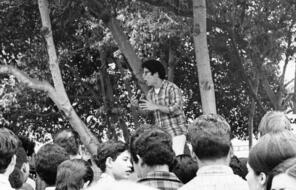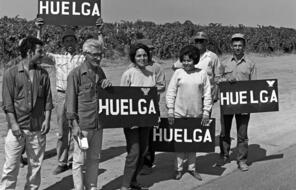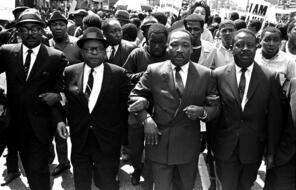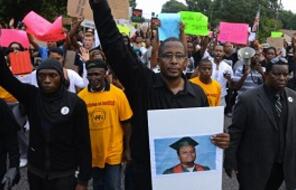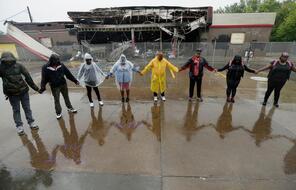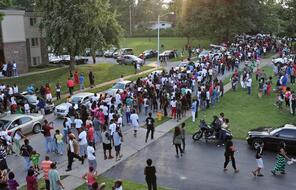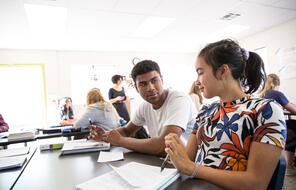Selling Progress: A South African Filmstrip for American Students
Subject
- History
- Social Studies
Language
English — USUpdated
Beginning in 1977, the South African government undertook a quiet but major campaign to convince Americans that the policy of apartheid was reasonable. The South African government sent beautifully illustrated magazines to libraries and offices across the US. The government organized all-expenses-paid tours to South Africa for journalists and other influential Americans. The government also focused on American schools, distributing for free a seemingly innocuous audio-visual program used to introduce students to South Africa. The document below is the transcript of that program. 1
[American narrator:] I know! It’s San Francisco, California; that’s Bryce Canyon, Utah; Levittown NY; Death Valley; New Orleans, La; Great Falls, Montana; Boston, Mass; Seal Cove, Maine; Texas Tech in Lubbock. Yes sir! I’ve been there: that’s Big Sur country in California. Catching the top ten in Kansas City.
[White South African narrator:] Not quite! We’re half a world away. Sixteen hours from NY by modern jet on a continent that most of us would never dream could be so similar to our own yet so different. Right down there is the very southern tip of the African continent, the fabled Cape of Good Hope. And right here is where the history of the modern Republic of South Africa began. It is an incredible story that parallels American history in many respects.
The first European explorers set foot here on the Cape back in the 1400s while in search for a sea route around Africa to the Orient, but the strategic importance of the Cape of Good Hope goes back to the mid-1600s when the Dutch established a major supply station here for ships in transit to and from the Orient. The subsequent settlement of the French, English, other Europeans and Asians, as well as the migrations of black people south from Central Africa, set into motion forces that have created an incredible 20th century mosaic of progress that is South Africa today.
Having such a diversity in range of cultures—from European to Asian to black African—we have had to solve many enormous problems . . . [Apartheid] has been designed to create several independent countries within the borders of the Republic of South Africa, where peoples with different customs and languages can live in a society where their identities will be preserved. Where our black people can control their own destinies, protected by law from the exploitation of others, including whites.
We think of our program of multinational development as an enlightened program and we realize that there are those who don’t agree with us. But we feel that they don’t understand what makes our situation different, really, from any other country in the world today.
And the situation for our black South Africans is quite different. He’s not just a black South African. He’s also a Zulu, a Xhosa, a Tswana, Tsonga, or South Sotho with deeply ingrained tribal and territorial traditions. This is a very important difference that some people are unwilling to accept. One of the primary problems of all developing African nations has been the destructive nature of ancient tribal feuds.
Schools by the thousands have been built to educate our black children as well as the adults who thought they’d missed their chance. 60% of black South Africans are literate; it jumps to 83% between the ages of 8-21 . . . We are preparing our black people for the time when they will be governing their own independent countries . . . The Xhosa have been governing themselves with our help for over fifteen years. So have the Tswana, Tsonga Venda, and north Sotho, they are all self-governing and now they have reached the last constitutional stages before being granted full independence.
We feel that it takes a step forward rather than backwards. Taking into account the hopes and aspirations of all South Africans. There are those who still believe that the best future of the black man will arrive when he has been remolded in the image of the white man. We reject this way of thinking. Black South Africans retain their separate identities and cultures.
South Africa has been moving peacefully to where foreign investments in South Africa today total 10 billion dollars. . . . Even as South Africans work to improve their own conditions in life they have an incredible abundance of natural resources to work with . . . Gold is one of South Africa’s leading exports and is the foundation of the world’s monetary system.
Conditions are ideal for growing cereal crops such as wheat and corn. Not only are sufficient quantities of cereal crops being grown to fill our own needs but also to supply other nations of the world from the surplus . . . The range of natural wonders and wildlife that can be seen in South Africa is unparalleled anywhere else in the world.
Modern South Africa in many respects is a living history of man. From the bushman of the Kalahari to a modern air force in the age of space exploration. South Africa today is truly a mosaic of progress. 2
Connection Questions
- As the narration begins, how does the narrator make you feel at home in his South Africa, a country thousands of miles from Europe and the US?
- In the 1970s, when US schools received this free documentary, teachers and students may not have noticed that it had been produced by the South African government. What difference would it make if students had known? What is the core argument in the filmstrip? What claims does the government offer to support this argument? The South African government believed that this document offered the truth about their country. They used many facts in the narration. Can a fact also be a falsehood? If it can, what would make a fact false? Are there examples here of facts that mislead? Even individual words can mislead readers. Are there examples here of such words?
- Now compare and contrast the ideas about apartheid put forward in this film and the ideas you have read about in this e-book. In particular, compare this document with the reading Mandela on Trial from Chapter 2, in which Nelson Mandela defends himself against the charge of treason. In both sources, the speaker is putting forth a view of South Africa. What criteria can you use to decide which document is offering the truth?
- 1South African Information Service, Mosaic of Progress (filmstrip, with accompanying educational poster), 1975. In the 1970s, documentaries were expensive and rare. Most schools used “filmstrips,” simple projected films, connected to an audio tape.
- 2“South Africa’s Mosaic of Progress: A Critique and Teaching Kit” (typed manuscript), compiled by N. Brian Winchester and Linda Wojtan (Bloomington, IN: African Studies Program, n.d.). Reproduced by permission of Indian University.
How to Cite This Reading
Facing History & Ourselves, “Selling Progress: A South African Filmstrip for American Students”, last updated July 31, 2018.

